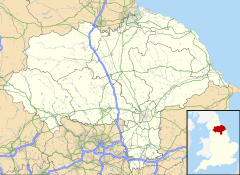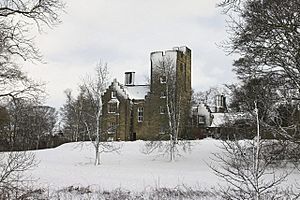Westerdale facts for kids
Quick facts for kids Westerdale |
|
|---|---|
 A view of Westerdale showing the village and part of the Dale |
|
| Population | 149 (2011 census) |
| OS grid reference | NZ665055 |
| Civil parish |
|
| Unitary authority |
|
| Ceremonial county | |
| Region | |
| Country | England |
| Sovereign state | United Kingdom |
| Post town | WHITBY |
| Postcode district | YO21 |
| Police | North Yorkshire |
| Fire | North Yorkshire |
| Ambulance | Yorkshire |
| EU Parliament | Yorkshire and the Humber |
| UK Parliament |
|
Westerdale is a small village and valley in North Yorkshire, England. It is part of the Scarborough area. The famous Esk Valley Walk path goes right through the village. Westerdale is special because it's where three small streams, called the Esklets, join together to form the start of the River Esk.
In 2011, about 149 people lived in Westerdale. This was a small decrease from the 175 people who lived there in 2001.
Exploring Westerdale's Geography
The Village of Westerdale
Westerdale village has about 25 houses along one main street. It sits northeast of a small stream that flows into the River Esk. In the village, you'll find Christ Church and an old, unused chapel. There's also a Village Hall, which used to be a school, plus a postbox and a telephone box. Long ago, people mined ironstone here. The village is about 10 miles south of Guisborough and Stokesley, and 20 miles west of Whitby.
Westerdale Side: A Nearby Area
Westerdale Side is another part of Westerdale. It's easiest to reach from the nearby village of Castleton. A narrow road runs along the southwest side of Castleton Rigg to get there.
Westerdale Moor: High Up and Wild
Westerdale Moor is a large, high area of land that surrounds the farms in Westerdale. The highest point on Westerdale Moor is 429 metres near Ralphs Cross. Baysdale Moor, which is nearby, reaches 433 metres at Stony Ridge. This makes it the second highest spot in the North York Moors.
Much of the moor is covered in peat (decayed plant material) and heather. As you go down into the valley, you can find bilberry plants and some bracken ferns. In wet areas, you might see Soft rush and sphagnum moss. There are also some trees like Alder, Mountain Ash, Birch, Oak, and Holly near the streams. In the 1800s, several coal mines were active on the moor.
Farming in the Dale
Even though Westerdale is in a remote, high area, people have been farming here for thousands of years. The soil can be different even in the same field, from sticky clay to loose shale. In the past, the richer fields grew crops like barley, oats, turnips, and potatoes. Today, most farms focus on growing grass for animals to eat and for making hay and silage to feed them in winter.
The fields are divided by many miles of dry stone walls and hedges. These walls have been built over a very long time and in different styles. In recent years, a lot of work has been done to protect and improve these walls and hedges. This work is supported by a program from the National Park.
Westerdale Hall: A Historic Building
Westerdale Hall is a large building made of stone with a slate roof. It's located near the west side of the village. It was built a long time ago as a special lodge for grouse shooting. After the Second World War, it became a popular youth hostel where young travelers could stay. Now, it is a private home, but it still looks much like it did when it was first built.
Hunters Sty Bridge: An Ancient Crossing
Hunters Sty Bridge is a very old stone arch bridge over the River Esk. It's located near the village, on the road towards Kildale. In the past, this route was very important for travelers going to Baysdale Abbey and Gisborough Priory.
The Duncombe family restored the bridge in the late 1800s, with a date stone showing 1874. However, the underside of the arch still has interesting Medieval stonework with ribs. People believe the Knights Templar might have helped build it, as it dates from their time.
The Esklets: Where the River Begins
The River Esk starts as many small streams in the upper part of Westerdale. This area is known as "The Esklets" and is close to Farndale. Not long ago, water was taken from these streams for public use, but that no longer happens. The old pumping station there is now empty.
Westerdale's Connection to the Knights Templar
Long ago, in the 1100s, some land and a hall in Westerdale were given to the Knights Templar. This was a famous group of Christian knights. The land was donated by Guido de Bovingcourt, who also owned other areas nearby. He was a supporter of the Cistercians, another religious group, and gave them land too. In Baysdale, he provided a home for a small group of Cistercian nuns. They were supported by mining and smelting (melting metal) rights near Westerdale village.
The old hall given to the Templars was located north of the current Westerdale Hall. In 1960, a young man named Paul Wheater dug there and found parts of the old building. He found evidence of a main room, a kitchen, a place for brewing drinks, animal shelters, and a chapel.
According to a book called The Story of Danby by Dr. Bob Robinson, the Templars of Temple Newsam in Leeds chose the Westerdale Preceptory (a Templar base) in 1119 to be the main center for Templars in North Yorkshire.
The Preceptory did well for about 200 years. But in 1309, the Templars were stopped from operating. William de la Fenne was the last leader (called a preceptor) of Westerdale's Templars. It's thought that as their group was about to be closed down, he encouraged his Templars to sell many of their valuable items for cash. A list of their belongings at that time was surprisingly small, especially since Westerdale was supposed to be the main Templar center in North Yorkshire. For example, their granary (where grain was stored) only had a small amount of rye.
We don't have much information about the exact borders of the Templar lands in Westerdale. However, many old stone crosses and markers stand on the moorland around this area. It's likely that some of these were used to mark the Templar boundaries. The Reverend George Young wrote in his History of Whitby and Streoneshalh Abbey (1817) that:
- many [stone crosses and markers] were set up to prevent disputes over territory and serve as landmarks......this plan was especially adopted by the Knights Templars and Hospitallers......



